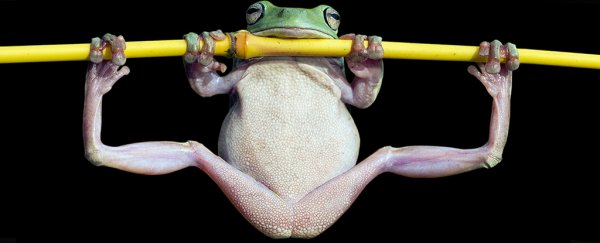The humble frog has been hiding a secret – like most birds, mammals, and a handful of reptiles, it has a kneecap.
This newly discovered piece of amphibian anatomy is barely a tiny blob of squishy cartilage, so nothing fancy, but the discovery could roll back our best guess on when kneecaps evolved.
A small team of Argentinian researchers were inspired by relatively recent discoveries of structures called sesamoids in species thought to be lacking in bony joint covers.
Sesamoids are bony material embedded in connective tissue such as the tendons over a joint. Knee caps, in other words.
They analysed the skeletons of 20 species of frog and found rudimentary structures that weren't quite sesamoids, but weren't like the surrounding connective tissue.
The kneecap, or patella, comes in all manner of shapes and sizes in different animals to suit slightly different forms of locomotion.
Have you ever wondered why we don't have an elbowcap?
Protecting a forward-facing joint could explain part of it, but the bony protrusion could also provide some mechanical benefit to what is essentially a lever required to swing a fairly heavy load as quickly and efficiently as possible.
Just recently researchers in the UK explored the purpose of the odd double-kneecap that seems to be exclusive to ostriches.
"We speculate that this might mean ostriches are able to extend their knees relatively faster than they would with one kneecap," says the study's lead researcher Sophie Regnault.
These benefits to walking mean before now, the evolution of the knee's sesamoid bone was presumed to coincide with the first tetrapods ambling about on dry land.
If amphibians like frogs and toads have a similar structure over their knees, it's possible the kneecap evolved out of something the first land animals brought with them.
"Until now it was thought that the evolution of kneecaps coincided with the arrival of tetrapods that lay eggs on land or retain fertilised eggs in the body," lead researcher Virginia Abdala of Argentina's Institute of Neotropical Biodiversity told Andy Coghlan at New Scientist.
"This investigation shows that the process really started with fibrocartilage in frogs," she says.
This fibrocartilage is hard to see, even under a microscope, which helps to explain why centuries of frog dissections haven't stumbled across them before.
Although small, it's thought to help absorb the strain of a bent leg as the frog sits, rather than provide any mechanical advantage.
"The resting position in frogs is analogous to the jumping position in humans, so the knees of frogs are under constant stress, and the fibrocartilaginous kneecap might alleviate this," says Abdala.
The discovery is an interesting one, but we probably shouldn't get too hasty about rewriting any text books yet. After all, what makes a kneecap a kneecap? Fibrocartilage pads to relieve strain aren't the same as bony blocks to help the leg swing.
Other animals also have squishy bits around their joints called patelloids.
There is also a leap in assuming 8 frog species represent thousands.
While biologists wrestle with those questions, it's interesting to consider that as the first tetrapods were creeping up onto muddy banks, there were structures that could evolve to help make moving their legs easier.
More frog dissections will provide more evidence on the matter. At least we've had plenty of practice by now.
This research was published in The Anatomical Record.
